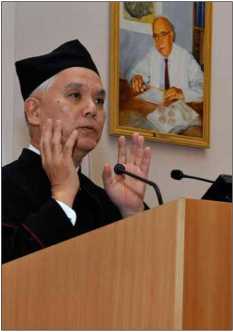8504862799
Gazeta AMG nr 1/2012
Wykład prof. Michinari Hamaguchi (streszczenie)
Src kinase: its role critical for tumorigenesis in human
My career started as a virologist. However, the fact that nearly 30% of Japanese die of cancer have led me to study celi transformation by oncogene. The focus of my study is to clari-fy the signaling pathway mediated by v-Src kinase, a product of oncogene encoded by Rous sarcoma virus. Transformation by v-Src has received considerable attention because of its elear and dramatic change of cells. Even though the processes involved in the development of cancers are complex, many aspects of oncogenesis can be reproduced in cells transformed by oncogene. In addition, the fact that activation of c-Src, a cellular counterpart of v-Src, is frequently observed in human cancers, strongly suggests the critical role of Src kinase for tumorigenesis in human.
Through the study of Src signaling as a model, we have identified several signaling molecules critical for anchorage-independent growth and for tumor invasion and metastasis. Following are some of our discoveries specially correlated with the topie of International Forum on Oxidative Stress and Aging dedicated to late Dr. J. Popinigis.
1) Redox-based control of Src-family kinases: Through the study of tyrosine kinases, we found that their activity is con-trolled by redox-based mechanism. These studies revealed a new mechanism of Src kinase activation. In addition, we identified a specific motif critical for the activation and inactivation of Src based on the modification of cysteinę residues. We named the motif as the CC motif and found that this motif plays a critical role for the sex hormone-based activation of breast cancer invasion. Some of these findings were already reported at the series of International Forum on Oxidative Stress and Aging dedicated to late Dr. J. Popinigis.
2) Identification of anoikis sensor system: anchorage-inde-pendent growth of cells, i.e. loss of anoikis, is a result of uncon-trolled celi growth mediated by oncogene product. Despite its importance, molecular mechanism that control anoikis re-mained largely unclear. We, for the first time, identified that SIRP (SHPS1)-SHP2 signaling system Controls the anoikis in v-Src transformed cells as well as human breast cancer cells. In these studies, we also showed that, without proper control by SIRP, SHP2 works to promote invasion.

In summary, our goal is to clarify the mechanism that causes escape from the anoikis and activation of the invasion and metastasis of human cancer cells and to develop molecular tools such as siRNA to inhibit tumor progression.
□
k W nauczaniu świętego Franciszka odnajdujemy tego L/ samego ducha obcowania z naturą.
' Gdańszczanie, dzięki istnieniu Jedwabnego Szlaku, mogą szczycić się wpływem na rozwój badań medycznych w Japonii (poprzez „autostradę cywilizacji", jak nazywa ją Felipe Fernandez Armesto). Najsłynniejszy gdański anatom, profesor Jan Adam Kulmus (1689-1745) podarował Europie, ale także i Japonii, ilustrowany podręcznik anatomii pt. Tabulae Anatomicae. Japońska wersja tego opracowania z roku 1774 pt. Koitoi Shinsho stała się najbardziej innowacyjnym i nowoczesnym podręcznikiem w całej Azji. Nowoczesnym, bo opartym o anatomię człowieka a nie zwierzęcia, co praktykowano dotąd w Chinach, a innowacyjnym, ponieważ europejski miedzioryt Japończycy zastąpili drzeworytem. To właśnie ilustratorzy Koitoi Shinsho wprowadzili cieniowanie obrazu fuki-bo-kashi, co wpłynęło na rozwój japońskiego drzeworytu ukijo-e.
Związki Gdańska z Japonią dostrzec można także w dziełach wybitnego gdańskiego filozofa Arthura Shopenhauera, który jako pierwszy wprowadził do filozofii europejskiej buddyzm. Matka filozofa, Joanna, była znana w kręgach gdańskiej bohemy owych czasów jako miłośniczka japońskiego jedwabiu i ceramiki.
Profesor Michinari Hamaguchi położył wybitne zasługi dla rozwoju współpracy pomiędzy Nagoya University a Gdańskim Uniwersytetem Medycznym. Jako dziekan Nagoya University School of Medicine, a następnie rektor Nagoya University, wspierał wymianę pracowników naukowych i studentów między Gdańskiem a Nagoją. Opisane przeze mnie - z konieczności jedynie skrótowo - osiągnięcia Profesora są dowodem jego wybitnych zdolności i zamiłowania do stawiania na to co nowe, innowacyjne. Profesor jest jednym ze światowych pionierów w dziedzinie biologii molekularnej nowotworów. Wybitne osiągnięcia profesora Hamaguchi, Jego pozycja w nauce światowej, stały kontakt z nauką polską i naszą Alma Mater zadecydowały o tym, że Gdański Uniwersytet Medyczny przyznaje mu dzisiaj zaszczytny tytuł doktora honoris causa. Obecność profesora Michinari Hamaguchi w gronie doktorów honoris causa naszej Uczelni przynosi nam zaszczyt.
□
Wyszukiwarka
Podobne podstrony:
Gazeta AMG nr 1/2012 • prof. dr hab. Monika Lichodziejewska-Niemierko,
Gazeta AMG nr 1/2012 prof. dr hab. Piotr Szefer, prof. dr hab. inż. Jacek Namieśnik - za autorstwo m
Gazeta AMG nr 6/2013 Gazeta AMG nr 6/2013Przemówienie dziekana prof. Wiesława Sawickiego Panie Rekto
Gazeta AMG nr 6/2012 Dr Marcelina Skrzypek-Czerko (od lewej) i dr Aleksandra Gaworska-Krzemiń-ska po
Gazeta AMG nr 6/2012 Gdańsk International Paediatric Liver Tumours Consensus Meeting in Conjunc-tion
Gazeta AMG nr 6/2012 raporty poszczególnych grup. Mark Krailo (USA) zaprezentował wstępną analizę
Gazeta AMG nr 6/2012 Z ŻYCIA UCZELNI JĘfk 51S5S im Dziekanem Wydziału Lekarskiego na
Gazeta AMG nr 6/2012 W numerze...Rektor GUMed Dżentelmenem Roku Rektor GUMed Dżentelmenem Roku
Gazeta AMG nr 6/2012 Gazeta AMG nr 6/2012 Sylwetki nowych profesorów tytularnychProf. dr hab.Andrzej
Gazeta AMG nr 6/2012 Gazeta AMG nr 6/2012 Chciałbym teraz zapytać kogo uważa Pan za swojego mis
Gazeta AMG nr 11/2014 Gazeta AMG nr 11/2014 Prof. Anna Lebiedzińska z aktualną doktorantką mgr Martą
13 Gazeta AMG nr 11/96 Prof. W. Zielińska we wspomnieniach pacjentki Taka była Pani
19 Gazeta AMG nr 11/96 prof. Stanisław Zawistowski Wspomnienia z czasów wojny cz.ll Tymczasem życie
Gazeta AMG nr 1/2012 Prezentujemy nowe technologie w CMISale operacyjne — integracja rozwiązań z obs
Gazeta AMG nr 1/2012 Gazeta AMG nr 1/2012 nansu do tych wyrafinowanych możliwości technicznych, byt
Gazeta AMG nr 1/2012 tak samo ważny ułatwi właściwe podejmowanie decyzji organizacyjnych. Jestem
Gazeta AMG nr 1/2012Dzień Wykładu w Gdańskim Uniwersytecie Medycznym Po raz pierwszy w historii nasz
Gazeta AMG nr 1/2012 dr n. bid. Krzysztofa Nagórska, Adam Ostrowski - Biologia molekularna przetnwal
Gazeta AMG nr 1/2012 dr Daniel Głód - za zaangażowanie w badania naukowe, których efektem jest wdroż
więcej podobnych podstron